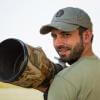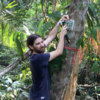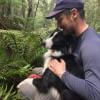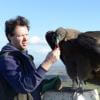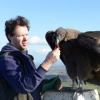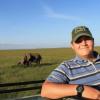Sensors already equip a range of tools to enhance monitoring capacity for conservation. Some of the higher bandwidth technologies, like camera traps and acoustic monitoring systems, have been essential elements of the conservation toolkit for decades, and thus have enough users that we've created dedicated WILDLABS groups to address them. But a whole range of lower bandwidth sensors beyond these core technologies are being increasingly integrated into conservation monitoring systems, and offer rich new insights into the wildlife and ecosystems we're all working to protect. As with many technologies, cost and access have historically been challenges to the adoption of new sensors, but with low-cost and open-source solutions on the rise, we're excited to see what the future of this space holds.
Getting Started with Sensors:
- Watch Shah Selbe's Tech Tutors episode on scaling FieldKit, an open-source conservation sensor toolbox, from a project to a successful conservation tech product.
- Check out our Virtual Meetup about Low-Cost, Open-Source Solutions in conservation tech, including a talk by Alasdair Davies on the Arribada Initiative's work with thermal sensors in early warning systems.
- For a more in-depth introduction, watch the first video in our datalogger mini-series: Freaklabs: How do I get started with Arduino?
In this group, you'll meet others who are using and innovating diverse sensors in their work, discuss ways to make sensors more effective & accessible for conservationists, learn about what sensors are already helping us accomplish in the field, and have the opportunity to ask and answer questions. Join this group to get started!
Header image: Emma Vogel, University of Tromsø
No showcases have been added to this group yet.
Tel Aviv University
- 0 Resources
- 0 Discussions
- 4 Groups
- 0 Resources
- 0 Discussions
- 3 Groups
Mars Omega
- 0 Resources
- 4 Discussions
- 7 Groups
Ticketmaster
- 0 Resources
- 0 Discussions
- 4 Groups
Camtraptions Ltd
- 0 Resources
- 0 Discussions
- 3 Groups
Forum for the Future
- 0 Resources
- 1 Discussions
- 2 Groups
- 0 Resources
- 0 Discussions
- 1 Groups
Arm
- 0 Resources
- 0 Discussions
- 4 Groups
- 0 Resources
- 0 Discussions
- 6 Groups
- 0 Resources
- 0 Discussions
- 2 Groups
- 0 Resources
- 0 Discussions
- 3 Groups
Wildlife Conservation Trust
- 0 Resources
- 0 Discussions
- 3 Groups
It’s one thing to hear that a project is working, it’s another thing entirely to see the data brought to life. Using submersible and aerial drones, as well as scientists with snorkels and digital cameras, The Nature...
4 October 2017
The Domain Awareness System (DAS) is a revolution in monitoring technology, creating real-time awareness of protected areas assets. This technology has the potential to completely change standard monitoring procedures...
26 September 2017
Article
As pressure on marine resources increases, fishers have to explore deeper and deeper waters to make a living. What does this mean for Belize’s deep-sea sharks? In an effort to understand the threats to these animals,...
26 September 2017
Article
Human-wildlife conflict can be difficult to understand without knowing its impact on people and communities. In this case study, authored by community member and Human Wildlife Conflict Tech Challenge coordinator Femke...
19 September 2017
Funding
The European Space Agency is calling for Kick-Start ideas to leverage space technology for wildlife protection. Three main topics of interest have been identified: 1) Wildlife monitoring, tracking and inventory, 2)...
5 July 2017
Its been a busy couple of months for the Open Acoustic Devices team. They've just returned back from Belize where they have been trialling the new AudioMoth design for gunshot detection. Find out what they've been up to...
27 June 2017
In this From the Field interview, we speak to Eric Becker, a conservation technology engineer at the World Wildlife Fund US. He talks about his work in technology design and the key challenges he's experienced...
22 May 2017
In this From the Field interview, we speak to Dr. Raman Sukumar, a world renowned expert on Asian elephant conservation. He shares his thoughts on how technology could be used for mitigating elephant-human conflict, and...
5 April 2017
How many samples do you hope to collect on your next field assignment? 50, 100 or 1000? How about billions. It may seem overly optimistic, but as Dr Phil Wilkes explains, that’s the reality when using Light Detection...
4 April 2017
Researchers have identified 15 emerging risks and opportunities for species and ecosystems around the world in a recent horizon scanning exercise.
31 March 2017
Satellite tracking is the state of the art of technology for mapping wildlife movement. But what if your budget is not state of the art? In our second From the Field interview, we're talking with WILDLABS member and GIS...
29 March 2017
Most people assume that research equipment is expensive and complicated. Yet it doesn’t need to be and the noise egg is a perfect example of this. It consists of a watertight container (as used by scuba divers) and the...
27 March 2017
August 2025
event
September 2025
event
March 2026
June 2020
March 2020
November 2019
event
17 Products
Recently updated products
121 Products
3 R&D Projects
84 Organisations
Recently updated products
Recently updated R&D Projects
Recently updated organisations
| Description | Activity | Replies | Groups | Updated |
|---|---|---|---|---|
| Will your startup be involved in sensor networks for conservation? I'm very interested. Currently we create sensor networks for developmental infrastructure and agriculture... |
|
Sensors | 6 years 5 months ago | |
| Hi everyone. I'm Akiba and I'm an engineer by trade specializing in wireless sensor networks and communications. I generally work with groups like World Bank on... |
|
Sensors | 6 years 5 months ago | |
| Subcutaneous pittags that also read temperature (frustratingly) read only a limited range of temperatures - however, I hear that can be... |
|
Sensors | 6 years 6 months ago | |
| Hi Ted, This is all very interesting. The solution you describe seems eminently doable and in fact quite cheap. So doable and cheap that it may behoove one to... |
|
Sensors | 6 years 6 months ago | |
| Yes, I agree it's a tough problem - i'm certainly stumped ;) but thanks so much for your reply and counter question - the goal is to find these gillnets and... |
|
Sensors | 6 years 8 months ago | |
| Hi Tony, I'm leading a cross disciplinary group of researchers at Deakin University in Australia to build new technology for monitoring wildlife and engage citizen scientists... |
|
Sensors | 7 years 4 months ago | |
| The current project is in open plains. From a handler perspective the distance will be from 20m -100m. I will be working at night so it will be looking for me target, the Plains... |
|
Sensors | 7 years 4 months ago | |
| @hikinghack used twitter to flag a thread on hackteria that members of this group might be interested in about DIY time-lapse soil... |
|
Sensors | 7 years 4 months ago | |
| Also if you are still looking for a solution this was published earlier this year and gives recommendations for soundscape microphones : http://onlinelibrary.wiley.com/doi/10... |
+5
|
Sensors | 7 years 9 months ago | |
| If anything belongs in the 'have you seen this' group, it's this project: Researchers at Binghamton University have created... |
|
Sensors | 7 years 10 months ago | |
| The University of Washington is reporting that they've shattered the long-range communications barrier for devices that consume almost... |
|
Sensors | 7 years 11 months ago | |
| My own experience is with the FLIR iphone attachment, just informal testing, but hasn't been that great at finding animals. I also think it would work better in the... |
|
Sensors | 7 years 11 months ago |



